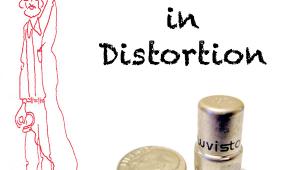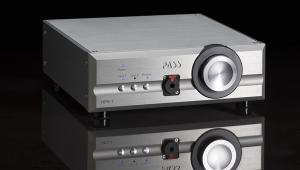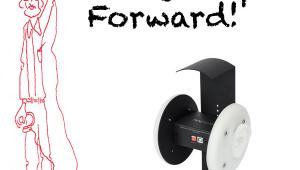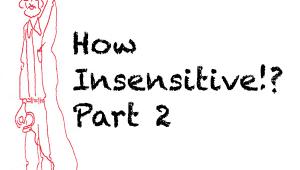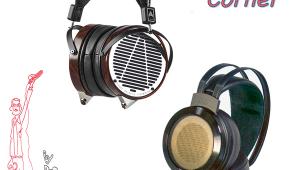| Columns Retired Columns & Blogs |
Katz's Corner Episode 18: Icelandic Wonder Page 2
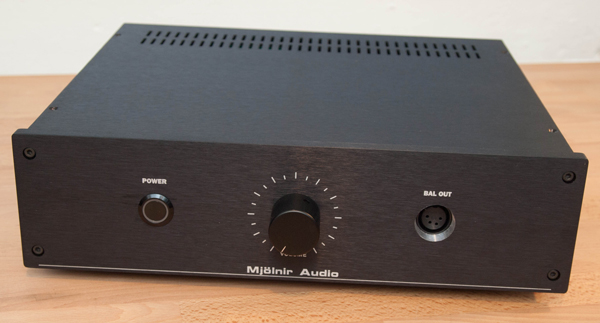
Fig. 18-4 Mjölnir Pure Bipolar Balanced Dynamic Headphone Amplifier
A New LCD-4 for Bob
When Audeze saw Tyll's report on my cans, they asked to examine them and decided to replace them, determining that they might have been damaged at some point. Honestly, I'm very glad whatever happened to my previous LCD-4s because this new pair is even more airy and extended at the high end. It definitely reflects Audeze's philosophy of continuous sonic improvement. If they can make it better, they will! I urge Sankar to send some latest samples to Tyll for measurement to demonstrate that my incredible sample is not a fluke. This won't be easy, these are expensive phones and probably every pair off the line is spoken for by a customer. If you're interested in a bargain, ask Audeze if there are any B-stock units available at a discount.
As you may know, uniquely, the LCD-4's printed circuit traces consist of a very thin layer of deposited aluminum that they "grow" onto the diaphragm over a period of a week. Whereas other planar headphones use traces made from a layer of aluminum foil. The LCD-4 deposition process results in what they claim to be the lightest planar-magnetic diaphragm in the industry. I have no reason to doubt them, because these latest LCD-4s are the "fastest" and most transparent LCDs I've ever heard, now rivaling the transparency of my Stax! But weight is not the only criterion for speed: The speed of diaphragm acceleration is proportional to several factors, including its weight, the number of traces (which governs the current that can be generated) and the magnet flux density, which is extremely high in the LCD-4.
Listening Comparison: The New LCD-4 and The "New" SR-007
Our ballpark has been completely rebuilt and effectively we have all new ball players, so let's run another shootout of the best of dynamic versus the best of electrostatic. We'll compare my "new" LCD-4, driven by the Pure Bipolar, and the SR-007, which has been completely renewed by the HV Carbon amp. We won't use any EQ to be on a level playing field. The player is J-River Media Center, TPDF dithered to 24 bits, feeding the Prism Callia DAC via USB. To preview: I think the Callia, to be reviewed in Episode 19, is one of the purest-sounding audiophile DACs on the market and it definitely contributes to the impressions below. I've adjusted the analog gains of the two headphone amplifiers to produce equal loudness and use J-River's dithered attenuator as a master volume control.
"Hold On" Amber Rubarth
Let's start with this recording of special merit: folk artist Amber Rubarth's excellent binaural record "Sessions from the 17th Ward", available from Chesky Records/HD tracks at 2496. This is a folk concert by estimable musicians in a perfect hall, and you're in an intimate front row seat. Kudos to my friend, engineer Nick Prout, who has produced a beautiful, natural, well-balanced reference recording. It sounds better on phones than speakers because it's binaural, and the depth and imaging in cans is amazing. It has a palpable holographic soundfield: you can practically reach out and touch the musicians. This recording translates pretty well to speakers, which is a rarity for binaural. I don't know how Nick did it, but thank you, Mr. Prout, for making this recording.
We'll play track 1, "Hold On". This is a simple arrangement, with solo female vocal, cello, fiddle and percussion. It's amazing how different two phones can sound yet each one is so pretty and involving. The vocal is more forward and has a bit more lower midrange presence in the LCD-4s, it's more laid back on the Stax. If we're to lay these sonic differences on tonality, overall my impression is the Stax has a linear tilt from, say, -1 at 20 to +1 at 20k. But with the HV Carbon, the sound is so pure that this curve is not at all bothersome as it would have been without compensation on the original KGSS amp. Dynamics and imaging are remarkably similar in the two phones. The ambience is more obvious in the Stax than in the Audeze, but the sound is fuller, warmer and more involving on the Audeze. The Audeze have adequate extension in the high end: Though there are no cymbals or tinkles on this recording to expose any weaknesses at the high end. I give this round marginally to the new Audeze, but definitely would not kick the Stax out of bed! Any other Audeze phone model would probably grade below these marvelous Stax. Only the new LCD-4s can equal or beat the Stax on this recording. Remember, only the LCD-4s have a deposited aluminum diaphragm, which makes it lighter than anything else except electrostatic.
"Morph the Cat" Donald Fagen
Next up, a piece of semi-pop music, Donald Fagen's Morph The Cat. We'll play the title track, at 2496 from HD tracks. On the Audeze, Fagen's voice has natural presence with perceptible sibilance, slightly exaggerated, but not annoyingly. Bass drum is solid but I could use a bit more punch circa 40 Hz that I think is on the recording. It's surprising to discover an LCD model which could use a bit more sub bass! Choruses are rich and build nicely. Cymbals are crisp and clear. Snare has very nice snap. Bass instrument is strong but not as strong as I've heard from my previous LCD-4s. Overall the sound is warm, clear, punchy and involving. My overall impression is the sound of the new LCD-4s is correct down to about 50, below which it could use up to a dB of boost. This is very minor and most people do not expect subsonic response from cans unless they've been exposed to one that can deliver in that zone.
Switching now to the Stax: The sound is clearer at the top end. Bass has more presence in its upper range. I think the bass fundamental is a hair light on the Stax compared to the LCD-4, but the harmonics make up for it. Fagen's voice has far more presence and the top end of the sibilance and the consonant "t's" exaggerated compared with the Audeze but probably tolerable because the chain sounds so seductive. Bass drum extends down just about as far as on the LCDs! This is the first time I would call a tie between the bottom end of the Stax and an LCD! A remarkable tribute to the bottom end of the KGSS Carbon. Despite the exaggerated sibilance, I give this round to the Stax because of the incredible, seductive presence. But likewise, I would not kick the LCD-4s out of bed!
Movement #1, Mahler Symphony No. 3, Vienna Philharmonic
Next up, the opening of movement #1 of Mahler Symphony No. 3, at 2488 from HD Tracks (Vienna Philharmonic, Pierre Boulez, mezzo-soprano Anne Sofie von Otter, Deutsche Grammophon). This is an astounding reference-quality recording with tremendous dynamic range. If you're not a Mahler fan, this recording will change your mind. Beginning with the Stax, all I can say is "marvelous". With other amplifiers, I've heard these cymbal crashes to sound too "sharp", but on the HV Carbon, they definitely sound just right. The tympani hits have impact and punch. You can hear all the detail in the strings, but the sound is richer than I've previously heard with this recording on the Stax. The builds are so involving they give me goosebumps! French horns and open trumpets are surrounded by a spacious ambience. The muted trumpets speak clearly and correctly. I'm completely involved in this performance; of course a lot is thanks to Gustav, but we have to give some credit to the seductive Stax phones! The pianissimo section with solo timpani is clear and detailed. Solo violin rich and sweet. I have been transported to the hall for the full, giant Mahler experience. It's hard to pull these phones off, because every moment of this piece is so rococo and involving. But I will switch to the LCD-4s because, well, it's my duty.
Starting from the top again, on the LCD-4s the cymbals are not as extended in the high end as in the Stax, but it's easy to get used to them. On the low end, the timpani sforzando is stronger and more involving than in the Stax. The timpani pianissimo solo is a bit less detailed and I kind of miss the detail that was present in the Stax, but if I had not had the comparison I would not have found any detail lacking. The sound is warm and involving. Then come the drum hits that are so impacting on the Audeze that I quickly forget my Stax experience and bathe in the uniquity of the LCD. Oh my god! That timpani and bass drum hit has just set my heart on fire. I'm in love. I don't want to leave the LCD-4 experience...you'll have to tear these phones out of my hands.
A memory jumps into my mind: My first gush of pleasure at hearing great headphones for the first time, the lushness of the original Sennheiser Orpheus, long before the SR-007 or LCD-4 came into existence. Both of these new phones driven by these superb amps evoke that Orpheus experience. Overall impression: This is a tie. The experiences with both the Stax and the Audeze may be different, but they are just as lovely, in different and satisfying ways.
"Change The World" Eric Clapton
Let's switch to nice pop: Eric Clapton's very consonant rock ballad "Change The World", a 1644 file ripped from CD. Beginning with the Stax, the sound is just perfect. Lead vocal and chorus are warm and clear. However, sibilance is very strong, obviously exaggerated in the recording with considerable 10 kHz distortion, but the tubelike Carbon warms the sound so nicely that those ss's are more tolerable than ever before on the Stax. The bass instrument has punch and strength. Overall the sounds wrap around the ears and are rich and clear.
We switch to the new LCD-4s: The sound is comparatively fatter and fuller on down. Eric's voice is warmer than on the Stax. The bass instrument and bass drum about equally solid on either can. The sibilance not as strong, in a good way. But the sibilant distortion is just as obvious as on the Stax. Overall I give a minute edge to the new LCD-4s on this song for its attractive warmth.
"Hourglass" James Taylor
James Taylor's "Hourglass", produced by Frank Filipetti, is an impeccable recording even at 1644. The SACD is out of print and quite expensive but I'm tempted to buy it. This is a very attractive pop record. The song Line 'Em Up, about Richard Nixon's last days in the White House, has perfect tonal balance with accurate sibilance. This is a reference-quality cut.
Beginning with the Stax/Carbon HV combination, I notice the bass goes down deep and clear. Remarkably, there does not seem to be anything lacking down to the deepest bass notes being played. James' vocal is warm and attractive. The cymbals are sweet and natural, not too bright. The ambience and space are perfect on these cans and the dynamics quite nice for a pop record.
Next we switch to the new LCD-4: Well, everything sounds comparable to the Stax up to about 12k, above which it seems at most 1 dB rolled off in comparison, but still sounding very nice. But which chain gives a more accurate presentation of this record? Given that the Stax high end has been a bit exaggerated up to now I need to refer to the calibrated reference speakers to solve this riddle: The answer is—Neither! The reference speakers' high end above 12 kHz falls about midway between the LCD-4 and the Stax responses. So I conclude the Stax is a hair bright in that range and the new LCD-4 a little rolled off. Both cans in their respective chains present a very satisfactory high frequency picture with this record, so if you are picky about ? dB above 12k, then you're going to have to audition and make your own pick!
"La LLave" Xiomara
Singer Xiomara's Latin binaural album, engineered by Nick Prout on Chesky records, at 2496, has a very spacious and holographic image. It's very entertaining.
Let's start with the LCD-4s, playing track 1 "La LLave". The electric bass is the first thing that makes an impression, its sound goes down to the center of the earth. The lead vocal is centered and natural on her peaks, surrounded by a very natural reverberation. When she hits her peaks she moves from her chest voice to her head voice but that does not sound harsh or objectionable, simply natural with this signal chain. Chorus is well balanced, which is not easy to accomplish with a single point microphone. The percussion sounds beautiful and natural, reminds me of the Buena Vista Social Club album. It's tonally sweet and natural, as we would expect from a Chesky Record. I do not feel that anything is missing from this performance, you're there in the middle of the group.
Now let's switch to the Stax. The sound here is remarkably similar, with a bit more definition above 12k, a bit more lead vocal presence and a little less power in the lowest bass notes. This review is beginning to sound like an echo, but really it is turning into a remarkable demonstration of how closely we can now make the dynamic and electrostatic headphone experience, which I had never before felt was possible. Which headphone presentation do I prefer on this cut? It depends on what mood I'm in, but I'll give a sliver towards the Stax at this moment on this cut, because the harmonics of the percussion are so entertaining, even if they are a little brighter than real life. But if I'm in a more relaxed mood I'd pick the LCD-4s for this cut!
"Back To Your Heart" Lindsey Webster
I know Lindsey Webster's jazz/soul album "Back To Your Heart" intimately, having mastered it at 2496, and I'm cheating by listening to my 2496 master, but I guarantee the 1644 also sounds very very good.
Beginning with the Stax/HV Carbon chain, my reaction as mastering engineer is predictable at this point: There's a hair more presence than the actual master, a bit more bite on the cymbals, but this chain makes it all seem so effortless and pure that I'm quite happy with this presentation.
Switching to the LCD-4s: Again, my reaction is predictable: Sound is a hair warmer and fatter than the Stax, and in fact a tiny bit muted above 12k compared to the loudspeakers. But I can taste the touch of the sticks on the ride cymbals in the bridge, and the crash seems very natural.
Now I have to stop this review and try out the most delicate EQ for the LCD-4s. I ended up with Equilibrium set to 12151 Hz, minimum phase, +0.7 dB, shelf, DMG shape, Q 0.1. That's all I think this chain would need to match the reference loudspeakers very well or maybe beat the Stax on all the cuts. Yet this EQ is completely optional (at least if you can get a new pair of LCD-4s that sound like my new ones)!
Conclusion: Things have gotten a lot better in the "over the ear" headphone department. This shootout is officially a draw!
Pricing it Up
These systems do not come cheap, but at this price you get a headphone system that compares favorably to a multi-thousand dollar set of loudspeakers. Let's add it up:
- Electrostatic system: Stax SR-007 Mk2, $1965 from Amazon. My Stax have the Spritzer port mod, which I highly recommend. Anyone who is mechanically inclined can perform that mod. Amplifier: Mjölnir Audio KGSS HV Carbon: $4600 plus shipping. DAC: Prism Audio Callia, $1999. Plus a music player and a computer. Total electrostatic system cost, not counting shipping: $8564.
- Dynamic System: Audeze LCD-4, $3995. Mjölnir Audio Pure Bipolar, $2100 plus shipping. Prism Audio Callia, $1999. Total dynamic system: $8094.
So, the electrostatic system is about $500 more costly, but in my opinion, the sonics of both these systems are equivalent, running a little over or under the flat line depending which tonality you lean towards.
Ed. note: Sorry about your wallet. :)
- Log in or register to post comments
